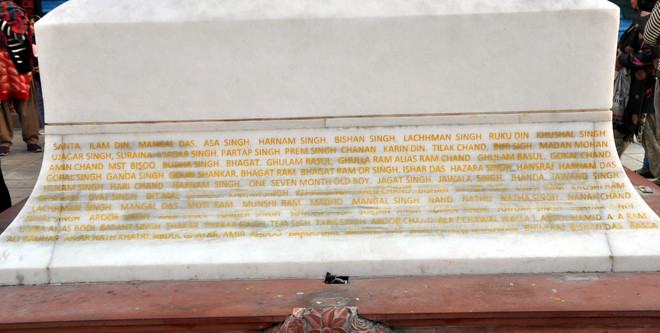List of Jallianwala martyrs published
Over a century after the Jallianwala Bagh massacre, an official list of 492 martyrs has been revealed, leading to a debate over its authenticity. A state-level function has been scheduled to honour the martyrs’ kin tomorrow at Amritsar’s Anand Park where a separate memorial would be unveiled.
The list is available on the Amritsar administration’s website. The relatives of the martyrs have been asked to submit documents to ascertain their antecedents. About a dozen people have submitted documents, claiming to be descendants of the martyrs. Historian V.N. Datta, who authored the pioneering work on Jallianwala Bagh (1969), claimed that around 700 people were killed. His daughter and associate professor Nonica Dutta, Department of Historical Studies, Jawaharlal Nehru University, says her father had zeroed in on this estimate on the basis of local police records.
Nonica told The Sunday Guardian that at the meeting of the Imperial Legislative Council on 12 September 1919 Congress leader Madan Mohan Malaviya had said that 1,000 people had been killed in the massacre. “There is no clarity on the number of martyrs to date.”
The list of the dead and injured prepared by the British then for the purpose of awarding compensation has several discrepancies. This list at the DC’s office has 501 individuals with many marked as “unidentified”. The list was pruned to 492, as several serial numbers were left blank. A recent study by the Partition Museum Trust put the number at 547 with the names of 45 not known. A board in the precincts of the Jallianwala Bagh earlier put the death toll at 379 and around 1,500 injured. This was published by the Jallianwala Bagh National Memorial Trust. Also, it was inscribed at the martyrs’ well from where 120 bodies were recovered later on.
Drivers’ Eyes Are Fine
The other day at an event Union Road Transport and Highways Minister Nitin Gadkari revealed that he was shocked to discover after a road accident
Canadian MPs want Nobel for Khalsa Aid
Canadian MP Tim Uppal, Mayor of Brampton Patrick Brown and the MPP for Brampton South Prabmeet Singh Sarkaria have officially nominated United Kingdom-based non-governmental organisation (NGO) Khalsa Aid for the Nobel Peace Prize for its humanitarian work. The organization has been providing rations and other relief material to Punjab and Haryana farmers protesting against agriculture laws at Delhi’s Tikri border and at other places.
A matter of personal liberty
It is always a pleasure to listen to Justice Siddharth Mridul, Judge, Delhi High Court. He is a scholarly person. The participants listened with rapt attention to Mridul at a webinar hosted by Dr Ram Manohar Lohia National Law University, Lucknow, and Confederation of Alumni for National Law Universities Foundation on “Bail & Jail: The Rule & The Exception”. “Individual rights, bail and constitutional rights are all interlinked concepts,” Mridul said pointing out that the concept of bail as a constitutional safeguard for the protection of liberty emerged “from the conflict between police power and presumption of innocence in favour of the accused.” Mridul cited an interesting history of bail jurisprudence. He said there was always a lot of struggle between citizens and the executive, in a quest for achieving personal liberties. He referred to an “Ashokan Rock” edict on personal liberty and the role of the King. Even in Kautilya’s Arthashastra, it is stated, he said that only the rule of law can guarantee liberty and security. Cyrus the Great, best known as the liberator of the Jewish people, who had been incarcerated in Babylonia by Assyrians, is accredited for the discovery of a cylindrical object called the Cyrus cylinder. The cylinder inscribed the duties of the king and the rights of the subjects, Mridul said, pointing out that even as far back as 3,000 years, there were enlightened individuals who thought about the rights and liberties of individuals. “The rights of individuals are threatened when the right of one individual diminish.”
Describing how personal liberty evolved in Britain, Mridul said the Magna Carta was drafted as a result of conflict between subjects and King John.
The principle of vis-a-voluntatis was prevalent then as per which the King was the repository of all strength and wisdom and thus, was above law. It is due to these beliefs and principles, King John ran into troubles with his subjects and as a result of loss in the battlefield, he had to promise his subjects “rights” as a result of which this great charter came about. It became the foundation for contemporary principles of parliament and remedies like Habeas Corpus. It gave rights to subjects against illegal imprisonment.
Later, Mridul said, it was annulled by Pope Innocent III. Towards the end of the 16th century, there was again an upsurge in interest for Magna Carta. Clauses of Magna Carta were numbered in 63 categories and thus, Magna Carta became synonymous with individual liberty.

